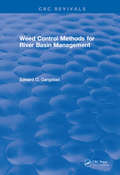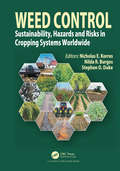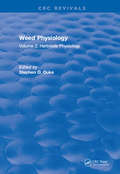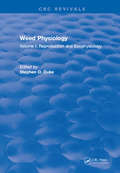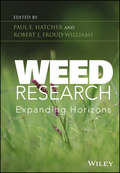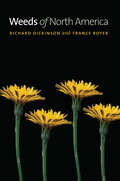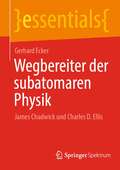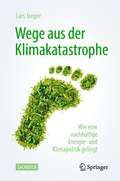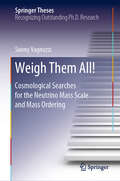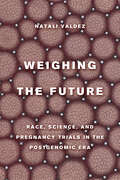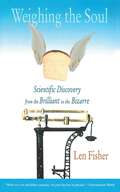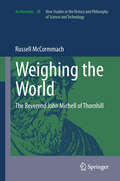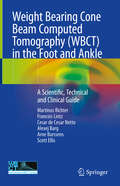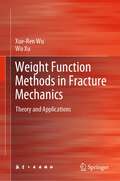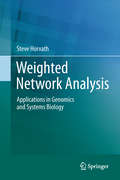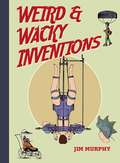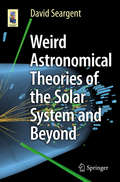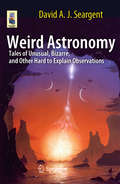- Table View
- List View
Weed Control Methods for River Basin Management
by E.O. GangstadAquatic plants continue to create problems associated with navigation, flood control, agriculture, irrigation and drainage, values of lands, conservation of wildlife and fisheries, and water resource supply. While much research is being done to find more effective and economic control measures, there is now a great need to apply known facts to achieve a measure of control by the means available. It is the purpose of this volume to provide a scientifically documented treatise of the known facts as they apply to the control of aquatic weeds in river basins and their allied waterways with particular emphasis on alligator weed and water hyacinth.
Weed Control: Sustainability, Hazards, and Risks in Cropping Systems Worldwide
by Nicholas E. Korres Nilda R. Burgos Stephen O. DukeIn light of public concerns about sustainable food production, the necessity for human and environmental protection, along with the evolution of herbicide resistant weeds, call for a review of current weed control strategies. Sustainable weed control requires an integrated approach based on knowledge of each crop and the weeds that threaten it. This book will be an invaluable source of information for scholars, growers, consultants, researchers and other stakeholders dealing with either arable, row, cash, vegetables, orchards or even grassland-based production systems. The uniqueness of this book comes from the balanced coverage of herbicide effects on humans and environment in relation to best weed control practices of the most important cropping systems worldwide. Furthermore, it amalgamates and discusses the most appropriate, judicious and suitable weed control strategies for a wide range of crops. It reviews the available information and suggests solutions that are not merely feasible but also optimal.
Weed Physiology: Volume 2: Herbicide Physiology
by Stephen O. DukeVolume 2 deals with the mechanisms of herbicide action and of resistance and tolerance to herbicides. The first five chapters of this volume cover the effects of herbicides and adjuvants on the physiology of plants. Professor Black‘s chapter begins by covering the effects of herbicides on photosynthesis, including photosynthetic assimilation of nitrogen, sulfur, and phosphorus. This is followed by Dr. Morelands chapter on herbicide interactions with plant respiration. The third chapter by Professor Bartels deals with the effects of herbicides on chloroplast and cellular development with emphasis on correlating physiological information with ultrasound effects.
Weed Physiology: Volume I: Reproduction and Ecophysiology
by Stephen O. DukeWeeds are plants existing at places and/or times at which they are considered undesirable by man. Thys, man‘s primary interest in weeds is in dinging methods for eliminating their presences. Understanding the physiology of weeds and how it differs from that of crop plants is becoming increasingly important in discovering new chemical, genetic, and cultural methods of controlling weeds. The two volumes of this book will aim to discuss the following; the physiology of weed production the ecophysiology of weeds, the mechanisms of herbicide action, and the mechanisms of herbicide resistance and tolerance.
Weed Research: Expanding Horizons
by Paul E. Hatcher Robert J. Froud-WilliamsThis book presents the most up-to-date and comprehensive guide to the current and potential future state of weed science and research. Weeds have a huge effect on the world by reducing crop yield and quality, delaying or interfering with harvesting, interfering with animal feeding (including poisoning), reducing animal health and preventing water flow. They are common across the world and cost billions of dollars’ worth of crop losses year on year, as well as billions of dollars in the annual expense of controlling them. An understanding of weeds is vital to their proper management and control, without which the reduction in crop yields that they would cause could lead to mass starvation across the globe. Topics covered include weed biology and ecology, control of weeds and particular issues faced in their control. Authored and edited by internationally renowned scientists in the field all of whom are actively involved in European Weed Research Society working groups, this succinct overview covers all the relevant aspects of the science of weeds. Weed Research: Expanding Horizons is the perfect resource for botanists, horticultural scientists, agronomists, weed scientists, plant protection specialists and agrochemical company personnel.
Weeds of North America
by France Royer Richard DickinsonAmerican Horticultural Society Book Award Winner: “An essential reference for all who wish to understand the science of the all-powerful weed.” —Better Homes and Gardens“What is a weed,” opined Emerson, “but a plant whose virtues have not yet been discovered?” While that may be a worthy notion in theory, these plants of undiscovered virtue cause endless hours of toil for backyard gardeners. Wherever they take root, weeds compete for resources, and most often win. They also wreak havoc on industry—from agriculture to golf courses to civic landscape projects, vast amounts of money are spent to eradicate these virile and versatile invaders. With so much at stake, reliable information on weeds and their characteristics is crucial. Richard Dickinson and France Royer shed light on this complex world with Weeds of North America.Organized by plant family, this encyclopedic volume features over five hundred species in two-page spreads with images and text identification keys. Species are arranged within family alphabetically by scientific name, and entries include vital information on seed viability and germination requirements. No matter what your philosophy on weeds, this guide provides much-needed background on these intrusive organisms. In the battle with weeds, knowledge truly is power, and Weeds of North America is perfect for gardeners, botanists, nature lovers, or anyone working in the business of weed ecology and control.“Royer’s photographs are almost perversely alluring. . . . How can you not be ensnared by a book populated by prostrate pigweed, tansy ragwort and dog-strangling vine?” —New York Times Book Review
Weeds: In Defense of Nature's Most Unloved Plants
by Richard Mabey“[A] witty and beguiling meditation on weeds and their wily ways….You will never look at a weed, or flourish a garden fork, in the same way again.”—Richard Holmes, author of The Age of Wonder“In this fascinating, richly detailed book, Richard Mabey gives weeds their full due.”—Carl Zimmer, author of EvolutionRichard Mabey, Great Britain’s Britain’s “greatest living nature writer” (London Times), has written a stirring and passionate defense of nature’s most unloved plants. Weeds is a fascinating, eye-opening, and vastly entertaining appreciation of the natural world’s unappreciated wildflowers that will appeal to fans of David Attenborough, Robert Sullivan’s Rats, Amy Stewart’s Wicked Plants, and to armchair gardeners, horticulturists, green-thumbs, all those who stop to smell the flowers.
Weekdays Story and Pictures
by Tizzie KnowlesIn this rhyming book, a child describes his week of activities including a picnic and shopping.
Wegbereiter der subatomaren Physik: James Chadwick und Charles D. Ellis (essentials)
by Gerhard EckerDas Energiespektrum der Elektronen beim Betazerfall war lange Zeit umstritten. 1914 fand Chadwick Hinweise auf ein kontinuierliches Energiespektrum, doch seine Ergebnisse wurden nicht allgemein anerkannt. Chadwick und Ellis lernten einander in einem deutschen Internierungslager während des 1. Weltkriegs kennen. Ellis gelang im Jahre 1927 der endgültige Beweis für das kontinuierliche Spektrum. Damit war der Weg frei für Paulis Neutrino-Hypothese und für die Fermi-Theorie der schwachen Wechselwirkung. In Streuexperimenten mit Alphateilchen fanden Rutherford, Chadwick und andere ab 1920 Hinweise auf eine bis dahin unbekannte Kernkraft, die wir heute als starke Wechselwirkung bezeichnen. Die Entdeckung des Neutrons durch Chadwick im Jahre 1932 war ein entscheidender Beitrag zum Verständnis beider Kernkräfte. Die Biografien der beiden Physiker werden beleuchtet.
Wege aus der Klimakatastrophe: Wie eine nachhaltige Energie- und Klimapolitik gelingt
by Lars JaegerÜberschwemmungen, Artensterben, Völkerwanderungen, Dürren, Supertornados - der Klimawandel ist keine am Horizont drohende Gefahr mehr, sondern längst in unserem Alltag angekommen. Die Lage ist sehr ernst, aber wir haben durchaus Konzepte, den verheerenden Klimatrend aufzuhalten und umzukehren.Alle durch den Menschen erzeugten klimarelevanten Einflüsse lassen sich auf einen einzigen Faktor zurückführen: Energie. Wer die aktuelle Klimadynamik stoppen und sogar umkehren will, muss daher auch auf die drei zentralen Fragen zur Energie und dem Klima eine Antwort finden: Wie genau beeinflusst unsere bestehende Art des Energieverbrauchs das Klima? Welche Möglichkeiten haben wir, Energie ohne negative Klimaeffekte zu erzeugen? Welche technologischen Fortschritte werden uns dabei in der Zukunft konkret helfen?Lars Jaeger gibt einen Ausblick auf eine mögliche klimafreundliche Wirtschaft der Zukunft, beschreibt, wie eine ökologische Gesellschaft funktionieren kann und wie lokale Energiekonzepte weltweiten Erfolg haben können. Er kommt dabei mit einer klaren und optimistischen Botschaft: Wir verfügen schon heute über die technischen Möglichkeiten (und in der Zukunft umso mehr), um den verheerenden Klimatrend ohne signifikante Wohlstandsbeschränkung umzukehren. Die Hindernisse liegen vor allem in ökonomischen und politischen „Sachzwängen“ und partikulären wirtschaftlichen Interessenskonflikten. Diese zu überwinden, darum geht es in der zukünftigen Energiepolitik.
Weigh Them All!: Cosmological Searches for the Neutrino Mass Scale and Mass Ordering (Springer Theses)
by Sunny VagnozziThe three neutrinos are ghostly elementary particles that exist all across the Universe. Though every second billions of them fly through us, they are extremely hard to detect. We used to think they had no mass, but recently discovered that in fact they have a tiny mass. The quest for the neutrino mass scale and mass ordering (specifying how the three masses are distributed) is an extremely exciting one, and will open the door towards new physics operating at energy scales we can only ever dream of reaching on Earth. This thesis explores the use of measurements of the Cosmic Microwave Background (the oldest light reaching us, a snapshot of the infant Universe) and maps of millions of galaxies to go after the neutrino mass scale and mass ordering. Neutrinos might teach us something about the mysterious dark energy powering the accelerated expansion of the Universe, or about cosmic inflation, which seeded the initial conditions for the Universe. Though extremely baffling, neutrinos are also an exceptionally exciting area of research, and cosmological observations promise to reveal a great deal about these elusive particles in the coming years.
Weighing the Future: Race, Science, and Pregnancy Trials in the Postgenomic Era (Critical Environments: Nature, Science, and Politics #9)
by Natali ValdezEpigenetics, the study of heritable changes in gene expression, has been heralded as one of the most promising new fields of scientific inquiry. Current large-scale studies selectively draw on epigenetics to connect behavioral choices made by pregnant people, such as diet and exercise, to health risks for future generations. As the first ethnography of its kind, Weighing the Future examines the sociopolitical implications of ongoing pregnancy trials in the United States and the United Kingdom, illuminating how processes of scientific knowledge production are linked to capitalism, surveillance, and environmental reproduction. Natali Valdez argues that a focus on individual behavior rather than social environments ignores the vital impacts of systemic racism. The environments we imagine to shape our genes, bodies, and future health are intimately tied to race, gender, and structures of inequality. This groundbreaking book makes the case that science, and how we translate it, is a reproductive project that requires feminist vigilance. Instead of fixating on a future at risk, this book brings attention to the present at stake.
Weighing the Soul: Scientific Discovery from the Brilliant to the Bizarre
by Len FisherFrom the man who "puts the fizz in physics" (Entertainment Weekly), an entertaining and thought-provoking foray into the science of the bizarre, the peculiar, and the downright nutty! Winner of the IgNobel Prize in physics and the 2004 American Institute of Physics Science Writing Award, Len Fisher showed just how much fun science can be in his enthusiastically praised debut, How to Dunk a Doughnut. In this new work, he reveals that science sometimes takes a path through the ridiculous and the bizarre to discover that Nature often simply does not follow common sense. One experiment, involving a bed, platform scales, and a dying man, seemed to prove that the soul weighed the same as a slice of bread. But other, no less fanciful experiments and ideas led to the fundamentals of our understanding of movement, heat, light, and energy, and such things as the discovery of electricity, and the structure of DNA; improved engines; and the invention of computers. As in his previous book, Fisher uses personal stories and examples from everyday life, as well as humor, to make the science accessible. He touches on topics from lightning to corsets and from alchemy to Frankenstein and water babies, but he may not claim the last word on the weight of the soul!
Weighing the Soul: The Evolution of Scientific Beliefs
by Dr Len FisherFrom the IgNobel-winning author of How to Dunk a Doughnut, another slice of the weird and wonderful side of scienceGood science and common sense often don't mix. In Weighing the Soul, Len Fisher shows the path to scientific discovery is frequently a bumpy one that follows Schopenhauer's famous maxim - 'All truth passes through three stages: First, it is ridiculed; Second, it is violently opposed; and Third, it is accepted as self-evident.' Fisher tells the fascinating, human stories behind some of the great as well as some of the not-so-great scientific ideas of the past - those that were truly bizarre, peculiar or downright daft, and those that just seemed that way at the time. As he shows, it is often only with hindsight that the two can be told apart, and it is some of those who appeared most wrong - and who were variously ignored, persecuted and imprisoned as a result - that ultimately went on to be proved most right.
Weighing the Soul: The Evolution of Scientific Beliefs
by Len FisherFrom the IgNobel-winning author of How to Dunk a Doughnut, another slice of the weird and wonderful side of scienceGood science and common sense often don't mix. In Weighing the Soul, Len Fisher shows the path to scientific discovery is frequently a bumpy one that follows Schopenhauer's famous maxim - 'All truth passes through three stages: First, it is ridiculed; Second, it is violently opposed; and Third, it is accepted as self-evident.' Fisher tells the fascinating, human stories behind some of the great as well as some of the not-so-great scientific ideas of the past - those that were truly bizarre, peculiar or downright daft, and those that just seemed that way at the time. As he shows, it is often only with hindsight that the two can be told apart, and it is some of those who appeared most wrong - and who were variously ignored, persecuted and imprisoned as a result - that ultimately went on to be proved most right.
Weighing the World
by Russell MccormmachThe book about John Michell (1724-93) has two parts. The first and longest part is biographical, an account of Michell's home setting (Nottinghamshire in England), the clerical world in which he grew up (Church of England), the university (Cambridge) where he studied and taught, and the scientific activities he made the center of his life. The second part is a complete edition of his known letters. Half of his letters have not been previously published; the other half are brought together in one place for the first time. The letters touch on all aspects of his career, and because they are in his words, they help bring the subject to life. His publications were not many, a slim book on magnets and magnetism, one paper on geology, two papers on astronomy, and a few brief papers on other topics, but they were enough to leave a mark on several sciences. He has been called a geologist, an astronomer, and a physicist, which he was, though we best remember him as a natural philosopher, as one who investigated physical nature broadly. His scientific contribution is not easy to summarize. Arguably he had the broadest competence of any British natural philosopher of the eighteenth century: equally skilled in experiment and observation, mathematical theory, and instruments, his field of inquiry was the universe. From the structure of the heavens through the structure of the Earth to the forces of the elementary particles of matter, he carried out original and far-reaching researches on the workings of nature.
Weight Bearing Cone Beam Computed Tomography (WBCT) in the Foot and Ankle: A Scientific, Technical and Clinical Guide
by Scott Ellis Martinus Richter Francois Lintz Alexej Barg Arne Burssens Cesar de Cesar NettoThis scientific, technical and clinical guide to Weight Bearing Cone Beam Computed Tomography (WBCT), written by the board of the International WBCT Society, presents all of the relevant content to date on the development, implementation, interpretation and clinical application of WBCT for the foot and ankle. Part One describes the history of the development of, and need for, WBCT as an imaging option and a scientific overview of the procedure. Part Two is an exhaustive scientific background, comprised of 16 landmark studies, describing its advantages for selected foot and ankle injuries and deformities (both congenital and acquired). With this science as context, Part Three includes chapters on the technical aspects and necessary background for WBCT, introduces the different devices, and provides insight into the actual measurement possibilities, including the initial software solutions for automatic measurements. Current clinical applications via case material are illustrated in atlas-like fashion in the next chapter, and a final chapter on future developments explores further applications of WBCT, such as dynamic scans and measurements or hologram-like visualization.The first book publication of its kind on this exciting and developing imaging modality, Weight Bearing Cone Beam Computed Tomography (WBCT) in the Foot and Ankle will be an excellent resource for orthopedic and foot and ankle surgeons, radiologists, and allied medical professionals working in this clinical area.
Weight Function Methods in Fracture Mechanics: Theory and Applications
by Wu Xu Xue-Ren WuThis book provides a systematic and standardized approach based on the authors’ over 30 years of research experience with weight function methods, as well as the relevant literature. Fracture mechanics has become an indispensable tool for the design and safe operation of damage-tolerant structures in many important technical areas. The stress intensity factor—the characterizing parameter of the crack tip field—is the foundation of fracture mechanics analysis. The weight function method is a powerful technique for determining stress intensity factors and crack opening displacements for complex load conditions, with remarkable computational efficiency and high accuracy.The book presents the theoretical background of the weight function methods, together with a wealth of analytical weight functions and stress intensity factors for two- and three-dimensional crack geometries; many of these have been incorporated into national, international standards and industrial codes of practice. The accuracy of the results is rigorously verified, and various sample applications are provided. Accordingly, the book offers an ideal reference source for graduate students, researchers, and engineers whose work involves fracture and fatigue of materials and structures, who need not only stress intensity factors themselves but also efficient and reliable tools for obtaining them.
Weighted Network Analysis
by Steve HorvathHigh-throughput measurements of gene expression and genetic marker data facilitate systems biologic and systems genetic data analysis strategies. Gene co-expression networks have been used to study a variety of biological systems, bridging the gap from individual genes to biologically or clinically important emergent phenotypes.
Weihnachtsbaum und Osterhase: Unsere Jahresfeste – biologisch betrachtet
by Bruno P. KremerMit diesem Buch lassen sich Feiertage wie Pfingsten, Halloween und Silvester neu entdecken. Lernen Sie in der Chronologie des Jahreslaufs einige bemerkenswerte kulturelle, z.T. auch überraschende und kuriose Hintergründe kennen und erfahren Sie, wie die jeweiligen organismischen Begleiter zu ihren spezifischen Einsatzgebieten kamen. Neben den kulturellen und kulturhistorischen Hintergründen der Feste widmet sich der Autor bestimmten Organismenarten, die als Symbolträger bekannt sind und oft auch kulinarisch mit bestimmten Feiertagen verknüpft werden, und stellt die gängigsten hinsichtlich ihrer Biologie vor. In den Kapiteln werden Fragen wie „Was ist der Kürbis für eine seltsame Frucht?“ und „Wieso ist Dezember nicht der zehnte Monat?“ thematisiert und erläutert. Sollten Sie also bisher noch nicht gewusst haben, dass der Osterhase ein Kaninchen ist, wie der Kürbis zur Halloween-Ikone wurde oder was es mit den Barbarazweigen auf sich hat, ist es zweifellos gut, dass Sie jetzt dieses Buch in Händen halten.
Weird & Wacky Inventions: More Weird And Wacky Inventions
by Jim MurphyA hair-cutting machine, a used gum receptacle, jumping shoes, and more of the strangest inventions ever! A hat that can tip itself. A suitcase that turns into a bathtub. A pair of protective eyeglasses for chickens. These are just three of the hundreds of unusual inventions that people have dreamed up over the last two centuries. Some, such as the mustache guard, made perfect sense when they first appeared. Others were considered just plain silly. Jim Murphy has compiled a collection of the weirdest and wackiest inventions and presented them in a quiz style that is challenging and fun. Simple, clear explanations are provided on how the inventions worked or failed to work. Complete with over 100 colored illustrations of these crazy creations, this is the perfect gift for any child interested in science and inventions. Ages: 9-12.
Weird Astronomical Theories of the Solar System and Beyond
by David SeargentAfter addressing strange cosmological hypotheses in Weird Universe, David Seargent tackles the no-less bizarre theories closer to home. Alternate views on the Solar System's formation, comet composition, and the evolution of life on Earth are only some of the topics he addresses in this new work. Although these ideas exist on the fringe of mainstream astronomy, they can still shed light on the origins of life and the evolution of the planets. Continuing the author's series of books popularizing strange astronomy facts and knowledge, Weird Astronomical Theories presents an approachable exploration of the still mysterious questions about the origin of comets, the pattern of mass extinctions on Earth, and more. The alternative theories discussed here do not come from untrained amateurs. The scientists whose work is covered includes the mid-20th century Russian S. K. Vsekhsvyatskii, cosmologist Max Tegmark, British astronomers Victor Clube and William Napier, and American Tom Van Flandern, a specialist in celestial mechanics who held a variety of unusual beliefs about the possibility of intelligent life having come from elsewhere. Despite being outliers, their work reveals how much astronomical understanding is still evolving. Unconventional approaches have also pushed our scientific understanding for the better, as with R. W. Mandl's approaching Einstein with regard to gravitational lensing. Even without full substantiation (and some theories are hardly credible), their hypotheses allow for a new perspective on how the Solar System became what it is today.
Weird Astronomy
by David A.J. SeargentWeird Astronomy appeals to all who are interested in unusual celestial phenomena, whether they be amateur or professional astronomers or science buffs who just enjoy reading of odd coincidences, unexplained observations, and reports from space probes that "don't quite fit." This book relates a variety of "unusual" astronomical observations - unusual in the sense of refusing to fit easily into accepted thinking, or unusual in the observation having been made under difficult or extreme circumstances. Although some of the topics covered are instances of "bad astronomy," most are not. Some of the observations recorded here have actually turned out to be important scientific breakthroughs. Included are some amusing anecdotes (such as the incident involving "potassium flares" in ordinary stars and the story of Abba 1, the solar system's own flare star!), but the book's purpose is not to ridicule those who report anomalous observations, nor is it to challenge scientific orthodoxy. It is more to demonstrate how what's "weird" often turns out to be far more significant than observations of what we expect to see.
Weird Dinosaurs: The Strange New Fossils Challenging Everything We Thought We Knew
by John PickrellFrom the outback of Australia to the Gobi Desert of Mongolia and the savanna of Madagascar, the award-winning science writer and dinosaur enthusiast John Pickrell embarks on a world tour of new finds, meeting the fossil hunters who work at the frontier of discovery. He reveals the dwarf dinosaurs unearthed by an eccentric Transylvanian baron; an aquatic, crocodile-snouted carnivore bigger than T. rex that once lurked in North African waterways; a Chinese dinosaur with wings like a bat; and a Patagonian sauropod so enormous it weighed more than two commercial jet airliners. Other surprising discoveries hail from Alaska, Siberia, Canada, Burma, and South Africa. Why did dinosaurs grow so huge? How did they spread across the world? Did they all have feathers? What do sauropods have in common with 1950s vacuum cleaners? The stuff of adventure movies and scientific revolutions, Weird Dinosaurs examines the latest breakthroughs and new technologies that are radically transforming our understanding of the distant past. Pickrell opens a vivid portal to a brand-new age of fossil discovery, in which fossil hunters are routinely redefining what we know and how we think about prehistory's most iconic and fascinating creatures.
Weird Dinosaurs: The Strange New Fossils Challenging Everything We Thought We Knew
by John Pickrell&“A tour de force…highlights the odd reptiles that roamed all corners of the earth millions of years ago.&”—Sydney Morning Herald From the outback of Australia to the Gobi Desert of Mongolia and the savanna of Madagascar, the award-winning science writer and dinosaur enthusiast John Pickrell embarks on a world tour of new finds, meeting the fossil hunters who work at the frontier of discovery. He reveals the dwarf dinosaurs unearthed by an eccentric Transylvanian baron; an aquatic, crocodile-snouted carnivore bigger than T. rex that once lurked in North African waterways; a Chinese dinosaur with wings like a bat; and a Patagonian sauropod so enormous it weighed more than two commercial jet airliners. Other surprising discoveries hail from Alaska, Siberia, Canada, Burma, and South Africa. Why did dinosaurs grow so huge? How did they spread across the world? Did they all have feathers? What do sauropods have in common with 1950s vacuum cleaners? The stuff of adventure movies and scientific revolutions, Weird Dinosaurs examines the latest breakthroughs and new technologies that are radically transforming our understanding of the distant past. &“This history of the discovery of some of the most outlandish creatures that ever lived, and the excitement of paleontological research, will be sure to both entertain and instruct.&”—Spencer Lucas, author of Dinosaurs: The Textbook, Sixth Edition &“Fascinating.... Readers learn of beautiful opalised dinosaur bones from Australia and a crested dinosaur found approximately 13,000 feet up Antarctica's Mt. Kirkpatrick, demonstrating that dinosaurs were widely distributed across the globe.&”—Publishers Weekly
